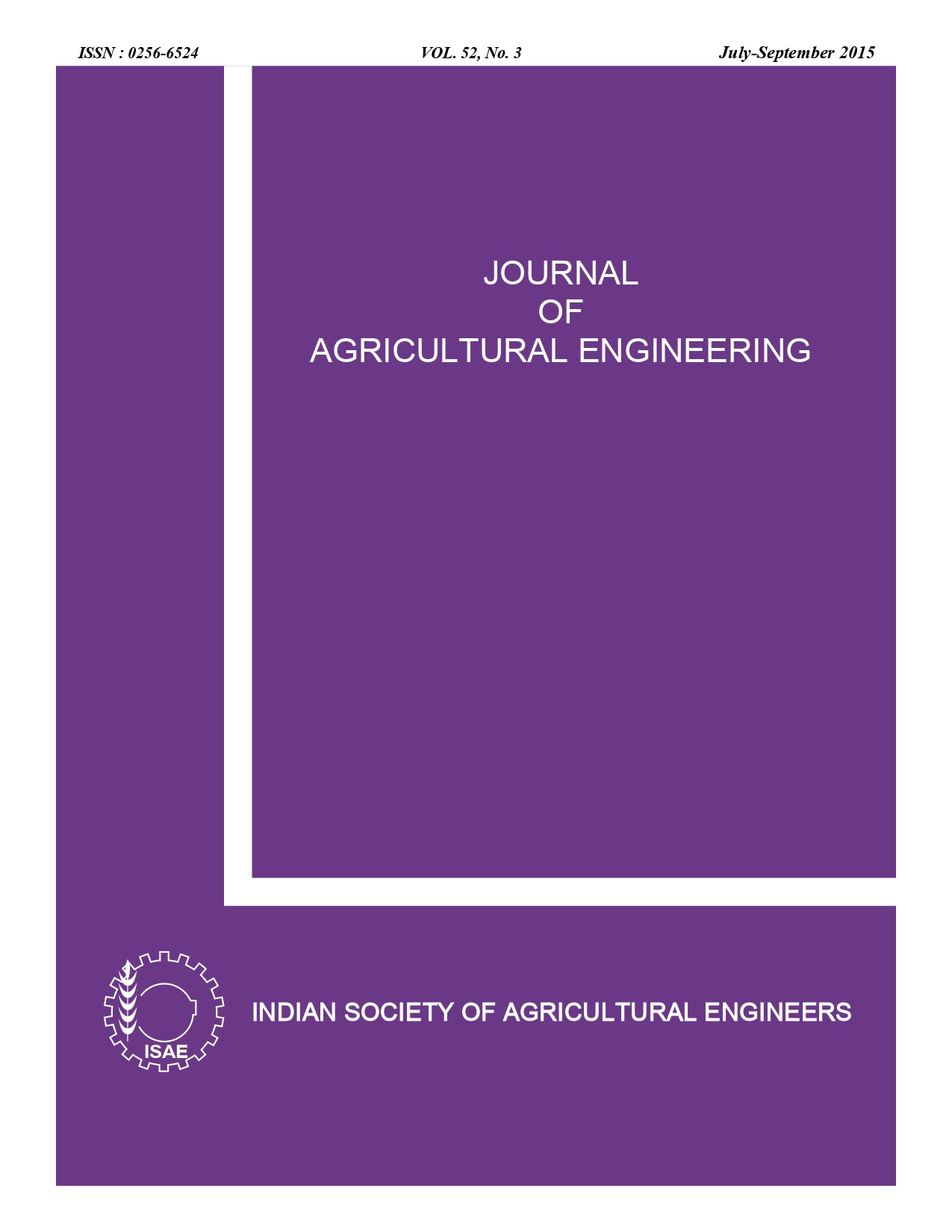Evaluation of Biodegradable Films from Tapioca Starch
DOI:
https://doi.org/10.52151/jae2015523.1584Keywords:
Physico-chemical properties, starch films, chitosan, tensile strength, WVTRAbstract
The present study was undertaken to investigate the physico-chemical properties of tapioca starch films. Biodegradable films were prepared with starch concentration ranging between 1.5% - 3.0%, and glycerol concentration between 20% - 30% of total starch. Chitosan, a known anti-microbial polysaccharide, was added to increase the mechanical strength of one of the films. Film having 3% starch and 20 % glycerol of total starch with a casting depth of 5 mm was found to be the best with tensile strength of 9.23 MPa, solubility of 17.22%, WVTR of 306.58 gm.cm-2.day-1 and thickness of 1.5mm. Chitosan addition at the rate of 1% was not effective in improving the films tensile strength.
References
Aider M. 2010. Chitosan application for active bio-based films production and potential in the food industry: A review. Food Sci.Technol., 43, 837-842.
AOAC. 2005. Official method of analysis. XIV Edition, Association of official Analytical chemist, Washington D.C.
Alves V D; Mali S; Beleia A; Grossmann M V E. 2007. Effect of glycerol and amylose enrichment on cassava starch film properties. J. Food Eng., 78,941-946.
Averous L; Moro L; Dole P; Frigant C. 2000. Properties of thermoplastics blends: starch - polycaprolactone. Carbohyd. Polym., 41, 4157-4167.
Bangyekan C; Aht-Ong D; Srikulkit K. 2006. Preparation and properties evaluation of chitosan-coated cassava starch films. Carbohyd. Polym., 63, 61-71.
Bourtoom T. 2008 .Plasticizer effect on properties of biodegradable blend film from rice starch-chitosan. Sonklanakarin J. Sci. Technol., 30, 149-165.
Chillo S; Flores S; Mastromatteo M; Conte A; Gerchenson L; Del Nobile MA. 2008. Influence of glycerol and chitosan on tapioca starch-based edible film properties. J. Food Eng., 88, 159-168.
Fama L; Flores S; Goyanes S S; Gerschenson L. 2007. Influence of storage time at room temperature on the physicchemical properties of cassava starch films. Carbohyd. Polym., 70, 265-273.
Fernandez C M; Karjalainen M; Airaksinen S; Rantanen J; Krogers K; Heinamaki J; Iraizoz Colarte A; Yliruusi J. 2008. Physical stability and moisture sorption of aqueous chitosan-amylose starch films plasticized with polyols. Eur. J. Pharm. Biopharm., 58, 69-76.
Flores S; Fama L; Rojas A M; Goyanes S; Gerschenson L. 2007. Physical properties of tapioca-starch edible films: influence of filmmaking and potassium sorbate. Food Res. Int., 40, 257-265.
Jangchud A; Chinnan M S. 1999. Peanut protein film as affected by drying temperature and pH of film forming solution. J. Food. Sci., 64, 153-157.
Kadam D M; Thunga M; Wang S; Kessler M R; Grewell D; Lamsal B; Yu C. 2013. Preparation and characterization of whey protein isolate films reinforced with porous silica coated titania nano particles. J. Food Eng., 117 (1), 133-140.
Kadam D M; Wang C; Wang S; Grewell D A; Lamsal B P; Yu C. 2014. Microstructure and antimicrobial functionality of nano-enhanced protein-based biopolymers. Trans. ASABE, 57 (4), 1141.
Lourdin D; Coignard H; Bizot H; Colonna P. 1997. Influence of equilibrium relative humidity and plasticized concentration on the water content and glass transition of starch materials. Polymer, 38, 5401-5406.
Mali S; Grossmann M V E; Gracia M A ; Martino M N; Zaritzky N E. 2006. Effect of controlled storage on thermal, mechanical and barrier properties of plasticized films from different starch sources. J. Food. Eng., 75, 453-460.
Mathew S; Abraham T E. 2008. Characterisation of ferulic acid incorporated starch-chitosan blend films. Food Hydrocolloid., 22, 826-835.
Muller C M O; Yamashita F; Laurindo J B. 2008. Evaluation of the effects of glycerol and sorbitol concentration and water activity on the water barrier properties of cassava starch films through a solubility approach. Carbohyd. Polym., 72, 82-87.
Parra D F; Tadini C C; Ponce P; Lugao A B. 2004. Mechanical properties and water transmission in blends of cassava starch edible films. Carbohyd. Polym., 58, 475-481.
Peas S S; Yakimets I; Mitchell J R. 2008. Influence of gelatinization process on functional properties of cassava starch films. Food Hydrocolloid., 22 (5), 788-797.
Pelissari F M; Yamashita F; Gracia M A; Martino M; Zaritzky E N; Victoria M; Grossmann E. 2012. Constrained mixture design applied to the development of cassava starch - chitosan blown films. J. Food. Eng., 108,262-267.
Reddy N; Yang Y. 2010. Citric acid cross-linking of starch films. Food Chem., 118(3), 702-711. Vengal J C; Srikumar M. 2005. Processing and studyof novel lignin-starch and lignin-gelatin biodegradable polymeric films. Trends. Biomater. Artif. Organs., 18(2),237-241.
Vengal J C; Srikumar M. 2005. Processing and study of novel lignin-starch and lignin-gelatin biodegradable polymeric films. Trends. Biomater. Artif. Organs., 18(2), 237-241.
Xu X Y; Kim K M; Hana M A; Nag D. 2005. Chitosan- Starch composite film: preparation and characterization. Ind. Crop. Prod., 2,185-192.














